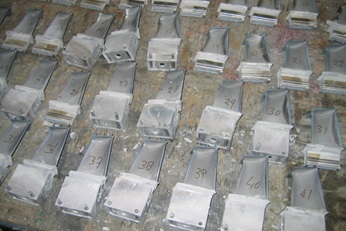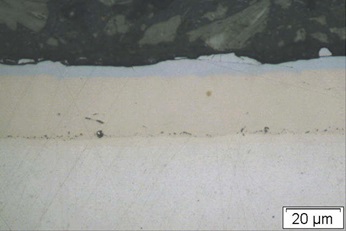Chemical vapor deposition CVD
Protect against oxidation and corrosion
Coating for internal passages and cavities
In a protective atmosphere, a chemical compound of the metal is evaporated or created in gas form away from the component to be coated. The vapor is transported by a carrier gas onto and into the component. The metal is released when the chemical compound decomposes, either by a temperature increase or by a shift in the chemical reaction balance when the metal is absorbed by the component.
Advantages of CVD include:
- Unlimited supply of coating metal, unrestricted coating thickness (theoretically)
- Ability to coat internal cavities
- Non-line-of-sight process: apply homogeneous coatings on intricate shapes
For gas turbine components, high-temperature CVD is commonly used to apply aluminum for an internal coating of hollow components. Components must be attached to a vapor distribution tool inside a protective atmosphere retort furnace. The coating thickness is controlled by time, temperature, and process gas flow.
The professional staff at Sulzer has the necessary training and equipment in selected locations in order to apply the various coating technologies to your components.
Diffusion coating
Pack cementation (also known as diffusion coating) is a process whereby components are packed in a powder mixture containing both the coating metal and chemicals that can form and carry the vapor for coating deposition. Pack cementation is a CVD process, although there is no visible flow of carrier gas.
As in other CVD processes, the carrier gas containing the metal is extremely sensitive to oxidation.
The coating heat treatments, which control thickness by length of time and temperature, must take place in a hydrogen-containing atmosphere inside a retort furnace.
Pack cementation is widely used for small turbine blades and vanes, as well as for the enrichment of MCrAlY-type overlay coatings with aluminum. MCrAlY coatings are alloys of M (Metal = nickel, cobalt, or iron, or a combination), Cr (chromium), Al (aluminum), and Y (yttrium).

